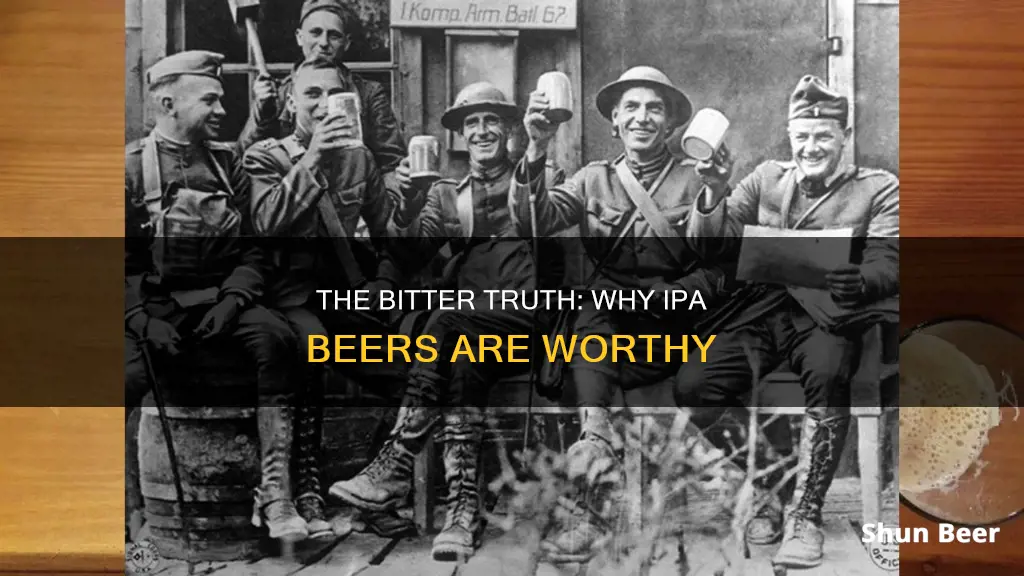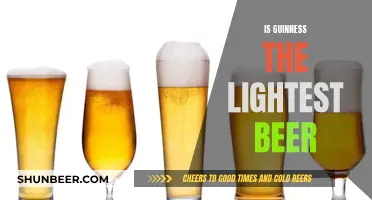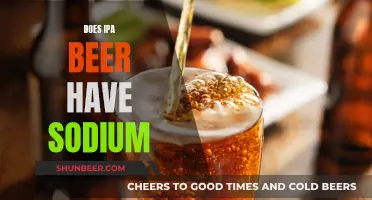
Indian Pale Ale, or IPA, is a style of beer that is known for its strong flavour and higher alcohol content. The name comes from British sailors who needed a beer that could withstand the long journey to India and its hot, humid temperatures. The use of hops as a preservative gave the beer its distinct, bitter taste and strong aroma. Over time, IPA recipes have evolved, and brewers now use different hop varieties to augment flavour rather than for preservation. Today, IPAs remain popular, especially in the craft beer world, with a wide range of styles and flavours available, from the traditional West Coast IPA to the trendy New England IPA.
| Characteristics | Values |
|---|---|
| What does IPA stand for? | India Pale Ale or Indian Pale Ale |
| Origin | British sailors in the 1780s |
| Reason for origin | Needed a beer that could survive the long journey from Britain to India |
| Flavour | Hoppy, fruity, bitter, malty, piney |
| Alcohol content | Varies, but often higher than other beers |
| Types | West Coast, New England, Session, Double/Imperial, Dry-Hopped, Triple Dry-Hopped, Single-Hopped, Fresh-Hopped, East Coast, Belgian, Sour, Brett, Lactose ("Milkshake"), etc. |
| Colour | Gold, amber, copper |
What You'll Learn

IPAs are popular because they have more flavour than regular beers
IPAs, or India Pale Ales, are popular because they have more flavour than regular beers. The IPA is a style of beer that is made with more hops, giving it a stronger flavour. While there is no standardised threshold at which a pale ale becomes an IPA, IPAs tend to be hoppier and bolder than pale ales.
The IPA was originally brewed in the UK in the 1780s and became popular with British soldiers and administrators serving in India. The beer was brewed to withstand the long journey from Britain to India, and the hops acted as a preservative. While the original British IPAs were malty, bitter, and one-noted, modern IPAs explore the world of fruity flavours that can be derived from hops.
There are many different styles of IPAs, including West Coast IPAs, New England IPAs, session IPAs, double IPAs, and triple IPAs. West Coast IPAs are known for their rowdy, fruity flavours, while New England IPAs are unfiltered, hazy, and have extremely low bitterness. Session IPAs have less alcohol, typically falling below 5% ABV, while double and triple IPAs have a higher alcohol content and a stronger, hoppier flavour.
In addition to their distinct flavour profile, IPAs also offer a range of other benefits. They are relatively easy to brew and can be sold at a decent price. They also have a higher alcohol content than many other beers, which is appealing to some drinkers.
Guinness Beer: Healthy Choice or Dark Deception?
You may want to see also

They are easier to brew than other beers
IPAs are easier to brew than other beers. Firstly, the generous amounts of hops used in IPAs often cover up minor mistakes. Hops act as a preservative, and so the beer is more forgiving about off-flavours. This means that IPAs are more forgiving of poor sanitation practices, although bad sanitation will still result in bad beer.
IPAs are also easier to brew because they are more flexible in terms of flavour. There is no standardised threshold at which a pale ale becomes an IPA, so it is up to the brewer to decide. This means that IPAs can be brewed with a wide variety of flavour profiles, from fruity to bitter.
IPA stands for Indian Pale Ale or India Pale Ale. The style was supposedly pioneered in the UK in the 1780s and became popular among British soldiers and administrators serving in India. The beer was brewed with lots of hops that could survive long journeys without going bad.
IPAs have since become very popular, especially in the craft brewing community. They are known for their strong flavour and higher alcohol content. However, it is important to note that not all IPAs are bitter, and not all IPAs have a high alcohol content. The style has evolved to include a wide range of flavour profiles and alcohol percentages.
The Rise of IPAs: Why Beer Lovers Are Hooked
You may want to see also

They have a higher alcohol content than other beers
IPAs, or India Pale Ales, are often associated with a high alcohol content. However, this is not always the case. While some IPAs have a higher alcohol percentage than other beers, there are also IPAs with a lower alcohol content than average beers.
The alcohol content of an IPA can vary widely, from 0% ABV to 13% ABV. The average IPA typically falls within the 5-7% ABV range, with some IPAs even reaching 10% ABV or higher. These higher-alcohol IPAs are often labelled as Double or Imperial IPAs. To balance the increased alcohol content, brewers use more malt, resulting in a stronger, hoppier flavour.
Session IPAs, on the other hand, are designed to have a lower alcohol content, typically below 5% ABV. These beers are meant to be consumed in larger quantities during a drinking "session" without becoming overly intoxicated.
The perception of higher alcohol content in IPAs may also be due to the rate at which the body can process alcohol. The higher alcohol content in IPAs, even if slightly above average beers, can cause people to feel the effects of alcohol more quickly.
Additionally, the body and maltiness of an IPA can affect how the alcohol is absorbed and perceived. IPAs tend to have a thicker body and more malt, which can enhance the feeling of intoxication compared to lighter beers with the same alcohol content.
In conclusion, while IPAs can have a higher alcohol content than other beers, this is not universally true for all IPAs. The wide range of alcohol content in IPAs allows consumers to choose based on their preferences, whether they desire a stronger or milder beer.
Is IPA Beer Sentiment a Myth or Reality?
You may want to see also

They are more profitable than other beers
IPAs are consistently ranked as the most popular craft beer style among American consumers. They are also popular in Australia, though not to the same extent. This popularity has led to a high demand for hops, the priciest ingredient in IPAs. Hops are a crop that is only harvested once a year, and the demand for its many sought-after varieties can increase its price.
The popularity of IPAs can be attributed to their distinct flavour and high alcohol content. They are also a symbolic answer to the American beer world that was dominated by mass-produced lager, which lacked flavour and alcohol content. IPAs, on the other hand, are strong in alcohol, have a full body, and a richness in flavour and aroma. They are also forgiving when it comes to fermentation and maturation temperatures and can cover up some minor mistakes and off-flavours.
The IPA trend has swept the nation and shows little sign of slowing down. This popularity, coupled with the high demand and cost of hops, makes IPAs more profitable than other beers.
The Evolution of the Guinness Beer Logo
You may want to see also

They are refreshing in hot climates
IPAs, or India Pale Ales, are refreshing in hot climates because they were originally brewed to withstand long journeys from Britain to India during colonial times. The hot and wet weather in India was not conducive to brewing good beer, so sailors needed a beer recipe that would be easy to preserve and not spoil during the voyage. Thus, IPAs were brewed with a high concentration of hops, which acted as a preservative and gave the beer its characteristic bitter taste.
The higher hops content in IPAs provides a stronger flavour and makes them more refreshing in hot climates. The hops in IPAs create a bitter taste that is balanced with fruity or floral notes, resulting in a crisp and refreshing beer. The additional hops also help to preserve the beer, ensuring that it stays fresh and tasty even in hot weather.
In hot climates, it is best to serve IPAs at slightly warmer temperatures than other beers, typically around 50 degrees Fahrenheit. This is because the flavours and aromas of IPAs are more subdued at colder temperatures. By allowing the beer to warm up slightly, drinkers can experience the full range of flavours and aromas that the beer has to offer.
IPAs have become increasingly popular in recent years, and their refreshing qualities make them well-suited for hot climates. The combination of a strong flavour profile, high hops content, and refreshing taste make IPAs a great choice for those looking for a crisp and tasty beer in warm weather.
The Magic Ingredients Behind the Popular IPA Beers
You may want to see also
Frequently asked questions
IPAs are known for their bitter taste due to their higher-than-average hop content. However, not all IPAs are bitter.
The ABV of an IPA can vary significantly, often ranging from 5% to 7% or more.
A session IPA has a lower alcohol content, usually below 5% ABV, making it perfect for those who want the flavour of an IPA without the higher alcohol content.
A double IPA, or DIPA, is an IPA with twice the amount of hops, resulting in a stronger, hoppier flavour. Double IPAs often, but not always, have a higher alcohol content.
An IPA is hoppier and bolder than a pale ale. Pale ales tend to have a lighter malt base and favour floral and fruity hops, while IPAs have a stronger flavour due to their higher hop content.







